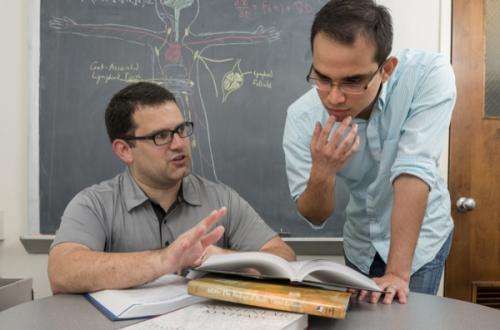Team develops mathematical model to measure hidden HIV

(Medical Xpress)—Scientists have long believed that measuring the amount of HIV in a person's blood is an indicator of whether the virus is actively reproducing. A University of Delaware-led research team reports new evidence that hidden virus replication may be occurring within the body's tissue, despite undetectable virus levels in the blood.
The findings were reported in the Journal of the Royal Society Interface on May 8 in a paper titled "Modelling HIV-1 2-LTR dynamics following raltegravir intensification."
The discovery came after the paper's lead author, Ryan Zurakowski, assistant professor of electrical and computer engineering, and his research team created a mathematical model to represent how HIV infected cells reproduce.
Antiviral therapy, Zurakowski explained, suppresses HIV replication in most patients until the concentration of virus in a blood sample is undetectable. It is unclear whether similar suppression occurs in other tissues, known as sanctuary sites, including lymph nodes where most HIV is found.
"The majority in the HIV community have always believed that the drugs are penetrating sanctuary sites perfectly well and that the blood is a good surrogate measurement of these sites," he said. "Our model gives us a way to measure this hidden virus replication, which has not been done before."
The research team used the model to analyze data from a clinical study in which researchers added a new drug, an integrase (enzyme) inhibitor, to the cocktail HIV patients were already taking. Patients tested were on a steady three-drug protocol for at least two years before adding the fourth drug, and never exhibited any measurable virus in their bloodstream.
According to Zurakowski, the inhibitor prevented the HIV DNA from integrating into a cell's chromosomes and caused the HIV DNA to bind its two ends together making a small DNA circle called a 2-LTR. The team's mathematical model revealed that 2-LTR circles can be measured in the blood and demonstrate virus replication in other tissues. It also showed that several patients with undetectable virus levels in their blood nevertheless had significant uncontrolled HIV replication in other tissues
"The genius of looking for 2-LTR circles is that infected cells can't survive the trip from the sanctuary site to the blood, and neither can the HIV, but the 2-LTR circles live as long as the cells that they are resident in, which is about 10-20 days," he said.
He continued on to say that the only thing stopping the virus from infecting more cells was that it was running out of healthy cells to attack. The team calculated that the virus infected and killed between 1 million and 100 million cells daily, numbers Zurakowski said are high enough that eventually it would lead the patient to develop a drug resistant HIV virus and to experience treatment failure.
Zurakowski said that for 30 percent of the patients in the study, adding integrase inhibitor caused 2-LTR measurements only explainable if the patient had uncontrolled virus replication in sanctuary sites in the body.
For HIV patients and the scientific community, the discovery implies that current antiretroviral therapies may not be as complete in suppressing HIV as previously hoped. Because the fourth drug causes additional 2-LTR's to be created, the model may also offer a new way to measure, through a blood test, whether HIV is reproducing in sanctuary sites in the body.















